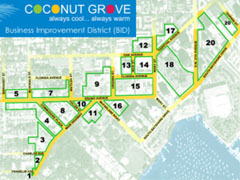
Coconut Grove on Biscayne Bay, Atlantic coast.
Source: coconutgrove.com
Just south of downtown Miami, Fla., along the Atlantic coast, Coconut Grove is a trendy neighborhood lined with boutique shops, open-air cafes and eclectic restaurants. It is also a great example of a community where a payment-in-lieu of parking (PILOP) program has been successfully implemented.
In the early 1990s, Coconut Grove had an overcrowded business district that required expanded parking facilities, but had little room available to build them. At the same time, the Grove did not intend to have parking affect its continuous storefront façade.
However, in 1993, the City of Miami passed an ordinance that required a minimum of one off-street parking space per 200 sq. ft. of gross floor area for large-scale establishments (defined as 20,000 sq. ft. or more). Smaller establishments are exempt from this regulation.
The law does more than set a parking minimum, however. It is particularly innovative because it provides an option for developers and property owners to opt out by making a payment in lieu of providing off-street parking. Owners can either pay a one-time fee of $5,400 per required opted-out space, or pay $50 per month. Therefore, businesses that expect to be in operation for the long term have an incentive to pay the one-time fee.
Ninety percent of parking waivers are deposited into the newly established Coconut Grove Parking Improvement Trust, which is used to enhance public parking facilities, offer infrastructure improvements, undertake maintenance and conduct marketing to serve the Coconut Grove Village Center. The remaining 10 percent of the collections are held in reserve for subsequent years, especially for large-scale projects such as the Oak Avenue Parking Garage.

Coconut Grove BID Map
Source: coconutgrove.com
Since the PILOP’s inception, developers have opted out of over 900 spaces, freeing valuable land for businesses to use while paying fees totaling $3 million by 2008. With an average parking space consuming 325 square feet, the sum of space saved amounts to close to 300,000 sq. ft. of land (equivalent to about six supermarkets) that can instead be used for more retail, restaurants or other amenities. More importantly, it allows owners and developers to make decisions on land allocation based on market demand for each property instead of a standardized rule.
All parking revenues go toward the Coconut Grove Business Improvement District (BID), a collaborative body with an elected board that also levies a special assessment on property to improve the area. In the BID’s initial years, from FY 2007-2009, the City of Miami contributed $200,000 annually from its General Fund to support the district’s launch. Table 1 gives an overview of the BID’s revenues spanning the last three fiscal years. Parking waivers and surcharges constitute a substantial source of income.
Table 1. Coconut Grove BID annual revenues, 2010-2012.
| Revenues |
FY 2010 |
FY 2011 |
FY 20121 |
| Parking Waiver Revenue |
200,000 |
160,000 |
194,300 |
| Parking Surcharge Revenue |
220,000 |
220,000 |
205,800 |
| Special Events Fees |
21,000 |
34,000 |
25,200 |
| Sidewalk Café Fee Revenue |
50,000 |
55,000 |
49,200 |
| Banner Fee Revenue |
2,250 |
3,000 |
2,500 |
| Investment Income |
115,000 |
106,600 |
88,700 |
| BID Assessments |
400,000 |
440,000 |
557,000 |
| General BID Fund |
402,000 |
587,300 |
--- |
| Other Income |
30,200 |
50,000 |
5,300 |
1 – Year covers 10/1/11 – 8/31/12.
Revenues fund neighborhood improvements in the BID, including public relations, marketing, grants for façade improvements, cooperative advertising, special events, capital projects, streetscape, sanitation and security. Funding also has supported a downtown circulator feasibility study, landscaping and traffic control device installations to improve parking and pedestrian access. Other initiatives include renovated brick sidewalks, a rejuvenated tree canopy, landscaping, a street cleaning crew and private security. Table 2 details the BID’s annual expenses.
Table 2, Coconut Grove BID annual expenses, 2010-2012.
| Expenses |
FY 2010 |
FY 2011 |
FY 2012 |
| Sanitation |
82,300 |
116,700 |
93,600 |
| Security |
239,900 |
238,400 |
158,300 |
| Streetscape |
249,000 |
119,900 |
80,800 |
| Marketing |
234,800 |
272,000 |
220,000 |
| General Admin |
383,800 |
368,600 |
348,900 |
| Special Events |
250,500 |
152,900 |
113,800 |

Coconut Grove Streetview
Source: Flickr User - AshtonColeman
With a population of 20,000 spread across six square miles, Coconut Grove stands out as a gem not only because of the shimmering waters of Biscayne Bay but also because it is a sustainable model of the built environment. Using parking as a management and improvement tool, Coconut Grove came up with a creative approach to determine how land should be managed to fund community and economic development initiatives. This South Florida neighborhood shows that parking can turn valuable spaces into vibrant places.
Solving the Parking Predicament Series
MPC’s Solving the Parking Predicament series offers an in-depth discussion of parking management. Beginning with a review of the parking problem and new strategies to solve them, each case study highlights best practices from around the country:
- Parking Meter Zones in Old Pasadena, Cali.,
- The SFPark smartphone app in San Francisco,
- The meter and permit system in Oak Park, Ill.,
- Performance Based Parking in Washington, D.C.,
- The EPA-piloted Parking Benefit District in Austin, Tex.,
- The Parking Improvement District in Boulder, Colo., and
- Payment-in-Lieu of Parking in Miami’s Coconut Grove neighborhood.
These case studies will show how parking can develop out of a headache and into a demand strategy that facilitates and supports the use of alternative modes of transportation, builds business activity, and boosts community ambience.
Through CMAP’s Local Technical Assistance program, MPC is working with the Wicker Park/Bucktown Special Service Area to analyze how variable priced parking—charging different rates for parking based on shifts in demand at different times or days of the week—can achieve just the right number of available parking spots. The study also will determine if variable priced parking would create additional revenue to support neighborhood sidewalk and transit improvements—a spot-on solution for drivers, businesses and the community.